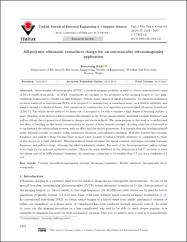All-polymer ultrasonic transducer design for an intravascular ultrasonography application
Özet
Intravascular ultrasonography (IVUS), a medical imaging modality, is used to obtain cross-sectional views of blood vessels from inside. In IVUS, transducers are brought to the proximity of the imaging targets so that high-resolution images can be obtained at high frequency without much concern of signal attenuation. To eliminate mechanical rotation rendered in conventional IVUS, it is proposed to manufacture a transducer array on a flexible substrate and wrap it around a cylindrical frame. The transducer of consideration is a capacitive micromachined ultrasonic transducer (CMUT). The whole device needs to be made out of polymers to be able to endure a high degree of bending (radius: 1 mm) Bending of the devices leads to considerable changes in the device characteristics, including resonant frequency and pull-in voltage due to geometrical dimension changes and stress induced. The main purpose of this work is to understand the effect of bending on the device characteristics by means of finite element analysis. Another objective of the work is to understand the relationships between such an effect and the device geometries. It is learned that the bending-induced stress depends strongly on anchor width, membrane thickness, and substrate thickness. It is also learned that resonant frequency and pull-in voltage become lower in most cases because of using a flexible substrate in comparison to those of the device on a rigid substrate. Bending-induced stress increases the spring constant and hence increases resonant frequency and pull-in voltage, although this effect is relatively weaker. For most of the device geometries, pull-in voltage is too high for the polymer material to endure. This is the main drawback of the all-polymer CMUT. In order to meet the design goal of 20 MHz resonant frequency, the membrane radius has to be smaller than 7.7 mu m for a thickness of 3 mu m.


















